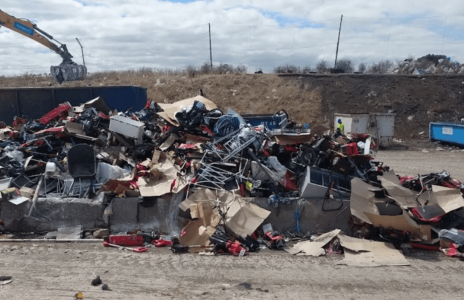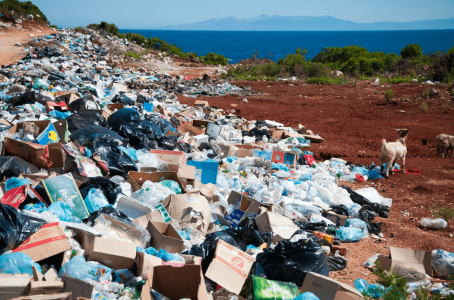Bunnings draws flak over ‘discarded’ stock
- Replies 13
In a world where customers are becoming increasingly mindful of the impact that companies have on the environment, it's no longer enough for businesses to simply pay lip service to sustainability.
Consumers are now holding companies accountable for their actions, demanding that they put their money where their mouth is when it comes to protecting the planet.
This shift in consumer attitudes has put many companies under the spotlight, and none more so than Bunnings.
Recently, the Australian hardware giant found itself in the middle of a social media storm after a photo on Facebook showed a massive pile of discarded Bunnings stock reportedly headed for a landfill.
The image, which featured rows of items, including power tools from the popular Ozito range (instantly recognisable for its red branding), sent shockwaves through the Aussie tradie community and beyond.

In a jaw-dropping Facebook post that has taken the internet by storm, a user has shared a shocking image of Bunnings' discarded stock.
The image features a massive pile of seemingly brand-new items, prompting many to question why such usable goods are being thrown away. The caption, which said: 'Bunnings return policy in action at a tip,' has sparked widespread outrage and disbelief.
As the post went viral, several members of the online community chimed in, raising questions about the quality of the items and suggesting alternative solutions.
One seasoned tradesman pointed out that Bunnings could have easily sold the products as 'damaged or repairable' or even as factory seconds for a fraction of the price. It begs the question - why was this not done?
But the issue goes beyond Bunnings.
People were also arguing about the broader impact of corporate waste on the environment, and some are suggesting for companies like Bunnings be ‘taxed heavily for unusable, damaged and repairable goods in their possession’.

But upon closer inspection, it turns out that the viral Facebook post about Bunnings' discarded stock might not be all that it seems.
After some careful sleuthing by eagle-eyed tradies, it was revealed that the photo was actually taken at Cleanaway Brooklyn Transfer Station, a recycling and recovery facility, and not a landfill, as previously claimed.
This discovery sheds new light on the situation and highlights the importance of fact-checking and doing due diligence before jumping to conclusions. While it's still unclear why the items in the photo were being discarded, it's worth noting that Bunnings does have a process in place for handling returned products.
According to Bunnings, they work with suppliers and a third party to assess and process returned products, with some items being resold via other channels.
However, there are also products that can't be sold due to safety concerns or damage, and it's these items that are sent to resource recovery centres for salvaging.

This revelation underscores the complexity of the waste management system and the need for more transparency around how companies handle their unsold or returned goods.
Bunnings has responded to the recent controversy over its waste management practices with a statement from its Managing Director, reaffirming the company's commitment to reducing its environmental impact.
In the statement, they emphasised the hardware store's dedication to the principles of the circular economy, which prioritise reducing, reusing, and recycling materials.
'We take our responsibility to the environment very seriously, and we are always looking for ways to improve our operations,' he said. 'That's why we are working closely with our suppliers to eliminate unnecessary packaging, divert more materials for recycling, and find new ways to reduce waste.'
He also highlighted some of the initiatives Bunnings has implemented to promote recycling and reduce waste. These include a battery recycling program for customers and a pot plant recycling program in stores.

It seems that not everyone is taking the recent Facebook post about Bunnings' discarded stock too seriously, with some tradies seeing the funny side of the situation.
In a light-hearted response, one group member commented that the Ozito products in the photo were only good for the tip anyway, with another suggesting that the cardboard boxes they come in have more integrity than the tools themselves.
However, others jumped to the defence of the tool brand, sharing their positive experiences with Ozito products that had stood the test of time. One fan even shared a story about an Ozito drill that they had used to mix plaster and paint for four years without burning out.
Despite this, there was some acknowledgement that the reason so many Ozito tools end up discarded is that tradespeople often use them for commercial or industrial use, which they're not designed for.
As one group member put it, 'They are home quality tools built to a budget to be used once or twice a month, not daily. Plasterers and painters are shocked by it.'

Overall, while the issue of waste management is a serious one, it's nice to see that some in the trades community were able to find some humour and levity in the situation.
What do you think of this story, folks? Were you also led to believe that the products were dumped in a landfill? It's interesting to see the different reactions to the original Facebook post and the subsequent revelations about the recycling facility. Let us know your thoughts in the comments!
Consumers are now holding companies accountable for their actions, demanding that they put their money where their mouth is when it comes to protecting the planet.
This shift in consumer attitudes has put many companies under the spotlight, and none more so than Bunnings.
Recently, the Australian hardware giant found itself in the middle of a social media storm after a photo on Facebook showed a massive pile of discarded Bunnings stock reportedly headed for a landfill.
The image, which featured rows of items, including power tools from the popular Ozito range (instantly recognisable for its red branding), sent shockwaves through the Aussie tradie community and beyond.

A photo recently making the rounds on Facebook is causing anger among Aussie tradies. Credit: Facebook.
In a jaw-dropping Facebook post that has taken the internet by storm, a user has shared a shocking image of Bunnings' discarded stock.
The image features a massive pile of seemingly brand-new items, prompting many to question why such usable goods are being thrown away. The caption, which said: 'Bunnings return policy in action at a tip,' has sparked widespread outrage and disbelief.
As the post went viral, several members of the online community chimed in, raising questions about the quality of the items and suggesting alternative solutions.
One seasoned tradesman pointed out that Bunnings could have easily sold the products as 'damaged or repairable' or even as factory seconds for a fraction of the price. It begs the question - why was this not done?
But the issue goes beyond Bunnings.
People were also arguing about the broader impact of corporate waste on the environment, and some are suggesting for companies like Bunnings be ‘taxed heavily for unusable, damaged and repairable goods in their possession’.

One eagle-eyed tradie was quick to point out that the photo had not been taken at a tip or landfill, as many assumed. Credit: Cleanaway.
But upon closer inspection, it turns out that the viral Facebook post about Bunnings' discarded stock might not be all that it seems.
After some careful sleuthing by eagle-eyed tradies, it was revealed that the photo was actually taken at Cleanaway Brooklyn Transfer Station, a recycling and recovery facility, and not a landfill, as previously claimed.
This discovery sheds new light on the situation and highlights the importance of fact-checking and doing due diligence before jumping to conclusions. While it's still unclear why the items in the photo were being discarded, it's worth noting that Bunnings does have a process in place for handling returned products.
According to Bunnings, they work with suppliers and a third party to assess and process returned products, with some items being resold via other channels.
However, there are also products that can't be sold due to safety concerns or damage, and it's these items that are sent to resource recovery centres for salvaging.

It's clear that Bunnings is taking steps to address the issue of waste, and it's encouraging to see a major retailer like this taking responsibility for its environmental impact. Credit: Facebook.
This revelation underscores the complexity of the waste management system and the need for more transparency around how companies handle their unsold or returned goods.
Bunnings has responded to the recent controversy over its waste management practices with a statement from its Managing Director, reaffirming the company's commitment to reducing its environmental impact.
In the statement, they emphasised the hardware store's dedication to the principles of the circular economy, which prioritise reducing, reusing, and recycling materials.
'We take our responsibility to the environment very seriously, and we are always looking for ways to improve our operations,' he said. 'That's why we are working closely with our suppliers to eliminate unnecessary packaging, divert more materials for recycling, and find new ways to reduce waste.'
He also highlighted some of the initiatives Bunnings has implemented to promote recycling and reduce waste. These include a battery recycling program for customers and a pot plant recycling program in stores.
Key Takeaways
- A photo posted on Facebook showed a pile of discarded Bunnings stock, including power tools, seemingly headed for the landfill, sparking outrage among group members.
- However, one tradie revealed the photo was taken at a recycling and recovery transfer station, not a tip, and the items were yet to be processed through Cleanaway's sorting and recovery procedures.
- Bunnings works with suppliers and a third party to assess and process returned products, with a portion being resold; only damaged or unsafe goods are sent to resource recovery centres for salvaging.
It seems that not everyone is taking the recent Facebook post about Bunnings' discarded stock too seriously, with some tradies seeing the funny side of the situation.
In a light-hearted response, one group member commented that the Ozito products in the photo were only good for the tip anyway, with another suggesting that the cardboard boxes they come in have more integrity than the tools themselves.
However, others jumped to the defence of the tool brand, sharing their positive experiences with Ozito products that had stood the test of time. One fan even shared a story about an Ozito drill that they had used to mix plaster and paint for four years without burning out.
Despite this, there was some acknowledgement that the reason so many Ozito tools end up discarded is that tradespeople often use them for commercial or industrial use, which they're not designed for.
As one group member put it, 'They are home quality tools built to a budget to be used once or twice a month, not daily. Plasterers and painters are shocked by it.'

Recycling and responsible disposal are crucial for a greener, sustainable future. Credit: Antoine GIRET.
Overall, while the issue of waste management is a serious one, it's nice to see that some in the trades community were able to find some humour and levity in the situation.
What do you think of this story, folks? Were you also led to believe that the products were dumped in a landfill? It's interesting to see the different reactions to the original Facebook post and the subsequent revelations about the recycling facility. Let us know your thoughts in the comments!







